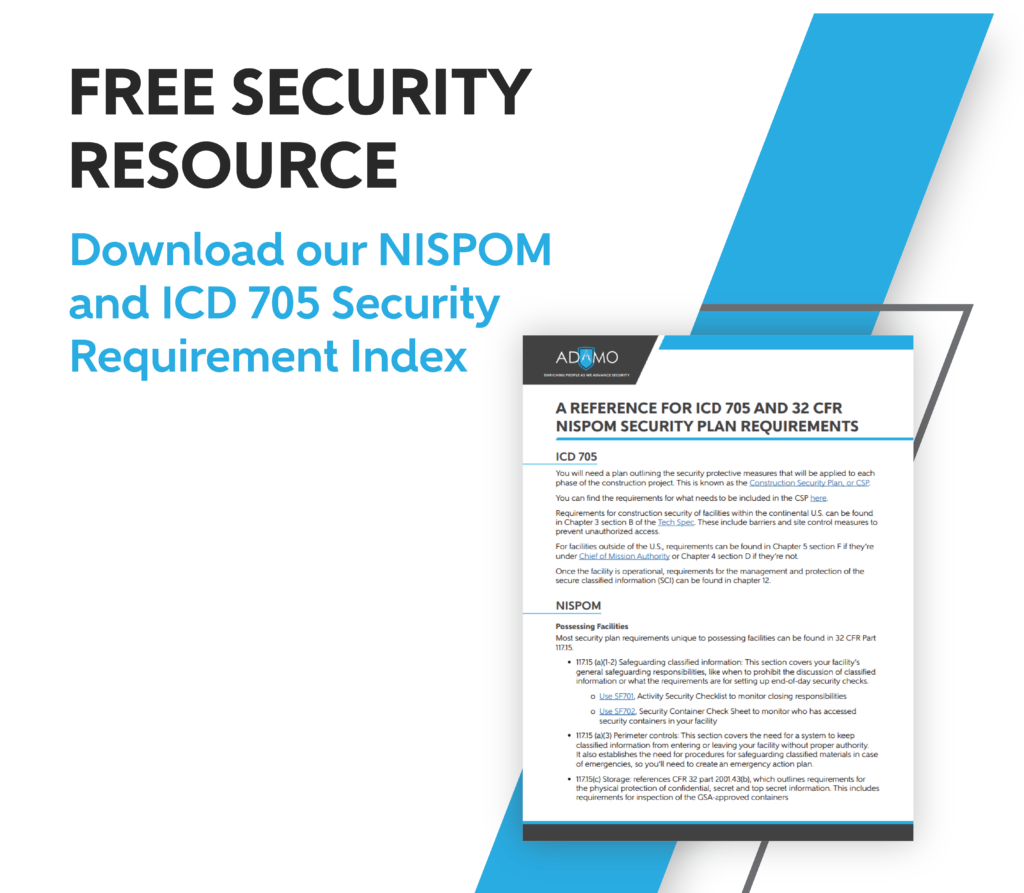How to motivate your personnel to be compliant with office security measures
When your company works with classified information, you need a security plan in place for a variety of things, from how the information will be stored to how the facility will be opened and closed each day. Requirements for these security plans exist in documents like the ICD 705 Technical Specifications, or Tech Spec, and the 32 CFR part 117, National Industrial Security Program Operating Manual (NISPOM). Different organizations like the DoD will also have their own policies for how information is to be protected.
The success of your security plan will depend on how well facility personnel know and abide by it.
Teaching the Security Plan
When a new employee begins at your company, there are a lot of security policies to learn at once. If possible, hold off on giving them closing and opening privileges until they learn the baseline requirements. However, if they do need greater responsibilities from the jump, one way to help them learn the plan is to assign a more senior employee to show them the ropes and watch out for them.

Your briefings and trainings will be the main way you’re able to educate your employees on the requirements. The more engaging you can make your briefings, the more likely it is that people will pay attention and retain the information you’re presenting. You can do this through things like adding humor to your presentations or incorporating games and competitions.
Even seasoned employees may need occasional help keeping all the requirements straight. Posters in heavily trafficked areas way serve as helpful reminders. These can be more fun, creative posters illustrating an idea, or straightforward lists of things like the process for opening and closing a GSA safe. These are wonderful if you want your employees to have a regular thing to reference. However, over time, they may fade into the background and be less attention grabbing, so they may be more helpful as a point of reference than a reminder.
For actual reminders, you may have to be more creative. One way of getting personnel to remember daily tasks could be setting up an audible reminder. For example, if you need people to remember to leave their phones behind when entering your secure space, record a message and add a motion sensor to the door that asks something like, “Did you remember to put away your phone?”
Enforcing security procedures will begin and end with you as a security leader. While an graduated scale of disciplinary actions is required for when employees fail to follow procedures, getting to know your employees can help you know how to best equip them to maintain their policies.
Why Your Leadership Matters
The culture you create around these policies will have a huge effect on how well personnel adhere to them as well as how willing they are to admit if they’ve made a mistake or forgotten protocol. Being available for questions, getting to know your employees and inspiring them to prioritize security are all things you can do as a leader to help others stick to the plan.
One way to inspire your workers is to make efforts to remind them of the bigger picture of the work they’re doing. It can be easy to get lost in the smaller day-to-day tasks, but it’s important to help them remember the work they do is an important part of national security.
Disciplinary action is not the only way to deal with employees slipping up when it comes to protocol. It’s important they feel they can self-report when things do go wrong. This comes from a foundation of trust that you as a leader build from day one through things like getting to know your employees during conversations about their lives outside of work. Make it known to employees that you’re available for their questions. Your workplace won’t be a perfect security machine, but employees who are willing to come forward when things do go wrong will ultimately make it more secure.
In the end, your leadership will set the example for the workplace. Make sure you are taking the steps to know the security procedures inside and out so you can follow them yourself and answer any potential questions your employees may have.
When you hold a Facility Clearance (FCL), maintaining facility security is top priority, but navigating the NISPOM can prove difficult. If your Facility Security Officer (FSO) duties are a heavy weight on your shoulders, consider partnering with Adamo’s FSO support services to ease your workload. Download our security plan requirements index for a guide on where to find office and site security requirements in the NISPOM and Tech Spec.




